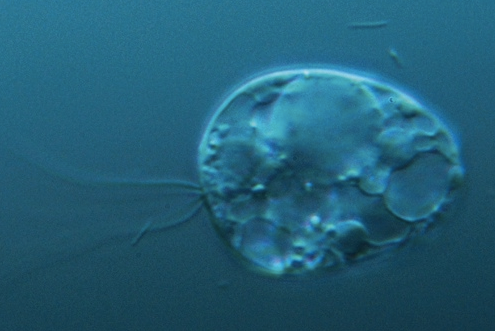New Primordial Protozoan Species Is Not in Any Known Kingdom of Life
A tiny microorganism found in Norwegian lake sludge may be related to the very oldest life forms on this planet,...

A tiny microorganism found in Norwegian lake sludge may be related to the very oldest life forms on this planet, a possible modern cousin of our earliest common ancestor. It is not a fungus, alga, parasite, plant or animal, yet it has features associated with other kingdoms of life. It could be a founding member of the newest kingdom on the tree of life, scientists said.
Life on Earth is divided into two main groups, the prokaryotes and the eukaryotes. Prokaryotes are simple life forms, with no membranes or cell nuclei; this group includes bacteria and archaea. Eukaryotes, which include humans, animals, plants, fungi and algae, have cell membranes and nuclei. This new organism is a eukaryote.
More specifically, it’s an algae-eating protozoan, a type of creature that have been known to science since the Civil War but which have lacked genetic studies because they’re difficult to culture. Researchers in Norway were able to harvest them from a lake bed and breed them in the lab. This one is called Collodictyon.
Researchers led by Kamran Shalchian-Tabrizi, head of the Microbial Evolution Research Group (MERG) at the University of Oslo, were examining the species’ genes and morphological makeup and found it is not like anything else. It evolved a billion years ago, give or take a couple hundred million years. It could have been living the same way since then, providing scientists a glimpse of what the earliest life forms looked like.
The organism is weird in several key ways. It has four flagella, for instance, which makes it different from bacteria and eukaryotes. Mammals, fungi and amoebae only have one flagellum — that’s the propeller-like feature that helps cells move (think of the “tail” of a sperm cell). Algae, plants and single-celled parasites called excavates are thought to have had two flagella. Collodictyon is somewhere between an excavate and an amoeba.
Also, the organism has the same internal structure as a parasite, but it uses amoeba-like protuberances to catch its food, which are blue-green algae. So again, it combines features from two branches of the eukaryotes, further evidence that it’s a primordial creature, the researchers say.
Even at its highest levels, the tree of life is mutable — the domain archaea was only recognized in 1990. So it wouldn’t be out of the question for this organism to spark an entirely new kingdom. The research on Collodictyon is published in the journal Molecular Biology Evolution.